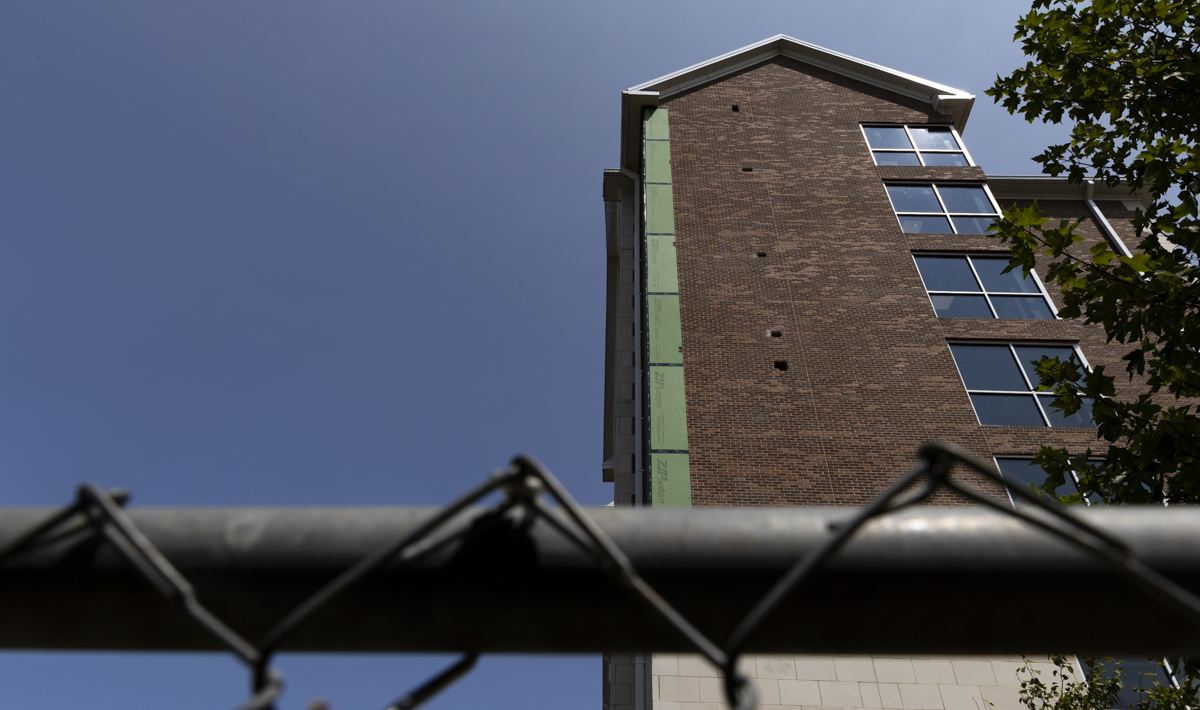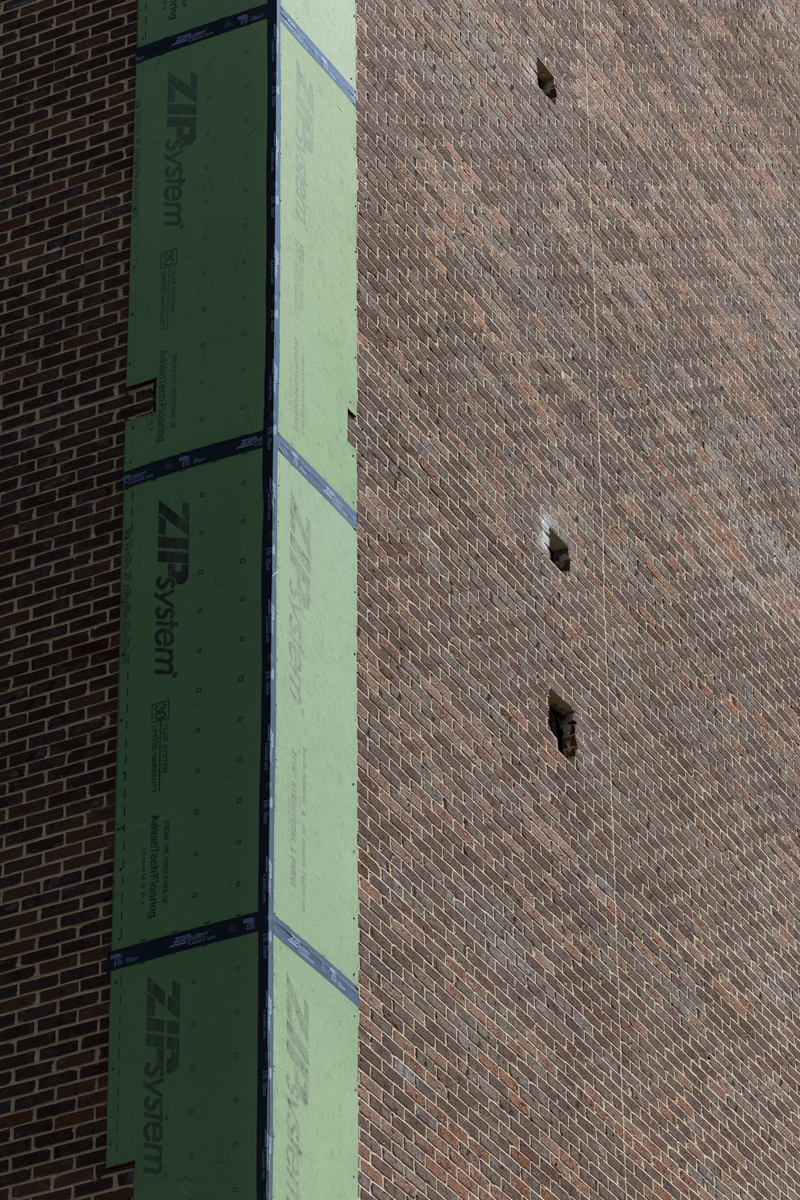On the surface, very little information on the status of Hilltopper Hall, WKU’s state-of-the-art residence hall that opened in 2018, has been provided since the Student Life Foundation, which owns WKU’s dorms, abruptly closed the building in February, saying that several investigations had found facade and masonry issues.
But according to reports the College Heights Herald obtained from the Foundation in a records request this summer, structural engineers and an architect hired to investigate the problems found significant design and construction flaws in both structural and exterior elements of Hilltopper Hall.
The reports consistently cite not meeting state building codes and an “inferior quality workmanship” that led to significant strain on the building’s structural components and failure in supporting its exterior veneer.
Tad Pardue, the attorney for the Foundation, said in an interview on Aug. 28 that the Foundation is currently working to create a plan for redesigning and repairing the building.
Pardue said the cost of repairs is still unknown, but repairs on both the outside facade and structural elements inside the building are going to take a “significant amount of time.”
The timeline
Work to build Hilltopper Hall began in January 2017 across the top of an area of campus known as The Valley, with an estimated completion date of June 2018, according to a plan application form submitted to Kentucky’s Department of Housing, Buildings and Construction on Feb. 10, 2017.
According to the form, the engineer and firm for the project was Donald Stoneburg of the Bowling Green-based firm S.E. Engineering. The architect of record was Nick Sewell of Bowling Green-based Sewell & Sewell Architect – which also, according to its website, worked on both Normal and Regents halls and the WKU Apartments on Kentucky Street.
Hilltopper Hall’s project contractor was Scott, Murphy & Daniel of Bowling Green. Pardue said he does not know who Scott, Murphy & Daniel hired as subcontractors – those who assembled the steel frame or laid the masonry.
Pardue told the Herald that issues with the stone and brick veneer were first noticed on the west corner of the south stairwell in August 2023.
In an email to faculty and staff in October 2023, the Foundation’s executive director, Catherine LaRoche, who also is WKU’s assistant vice president for Housing and Residence Life, said that during repairs on the “decorative stonework,” engineers identified other components that required further investigation, but the initial assessments showed no concerns with the building’s framework or structural integrity.
According to his veneer assessment report, Larry Schwering Architect, PPLC, was asked to visit Hilltopper Hall by Jackson Kelly, PLLC, in October 2023 to examine the property – specifically the south stair tower that saw noticeable veneer displacements.
Schwering said in the report that Brown+Kubican Structural Engineers (B+K) and Rick Hawkins of Hawkins Construction were also brought on by the Foundation to examine the building during fall 2023.

WKU administration maintained that Hilltopper Hall issues were primarily exterior. In a meeting with the Herald on January 10, 2024, WKU President Timothy Caboni briefly mentioned construction surrounding Hilltopper Hall, noting the shift in the masonry and the work being done to remedy it. However, he said it would not impact the daily lives of the hall’s residents.
Eight days later, on Jan. 18, 2024, LaRoche sent an email to all 388 Hilltopper Hall residents, informing them that the Foundation’s board of directors had concluded that, based on professional recommendations following investigations and assessments of the building, Hilltopper Hall would be closed. The following day, at a Board of Regents meeting, Caboni said safety concerns from experts assessing the building prompted the decision.
Students were given a deadline of Feb. 4 – 17 days after the announcement – to move out of Hilltopper Hall and into either a different campus residence hall, with an additional $1,000 in housing credit for that semester, or to move off campus with no housing credits but with that semester’s housing charge for living in Hilltopper Hall refunded on their spring bill. Students were given three days to make their choice.
Following the students’ departure from the building, there had been no further public announcements about the status of Hilltopper Hall, other than it would not open for the fall 2024 semester.
Through a request under the Kentucky Open Records Act to the Foundation on May 28, 2024, the Herald received documents that included reports from B+K and a report from Schwering that also included the building’s plan application form and a 2017 inspection report.
The Schwering and B+K reports noted poor workmanship in the construction of Hilltopper Hall, failure to follow state building codes and structural design errors that could potentially result in the six-story building swaying as much as 19 inches in high winds, according to the B+K analysis.
The structural findings
According to B+K’s report submitted on Jan. 19, 2024, Hilltopper Hall’s design was required to comply with the 2013 Kentucky Building Code – which is the 2012 International Building Code with Kentucky amendments.
“When subjected to the code-mandated load cases and various load combinations, many of the structural steel elements (beams and columns) fail to have the required strength,” B+K’s report said.
B+K found, through using their own software and the software used by the original structural engineer on record (Framework 2D + 3D, a proprietary and free application developed by G.M. Wolsink of the Netherlands), that the calculated stress of a structural element is greater than the allowable stress for that element’s strength.
In other words, the amount of force acting on various structural elements, compared to the amount of area it covers, was higher than what was allowable for the element’s performance.
“Based on these analysis results, combined with the excessively large calculated story drifts and the unpredictable nature of extreme wind and seismic events, it is our recommendation to discontinue occupancy of Hilltopper Hall until corrective action has been implemented and completed,” B+K’s report said.
B+K declined to elaborate on its report.

A significant concern that B+K found was excessive story drift, or the amount of sway a building has the higher it rises.
According to the analysis, Hilltopper Hall’s calculated story drift exceeded what was allowable by code by 600-900%. Near the ends of the building, the calculated drift was greater than what was allowed by as much as 1300%.
Sebastian Bryson, chair of the University of Kentucky’s department of civil engineering, said in an email on Monday that excessive story drift may lead to not only the facade falling off and damage to windows and doors, but also to structural damage on the upper floors.
B+K stated in the report that it is their opinion the excessive story drift is due to the steel framing design.
“At nearly all frames that are parallel to the building width, front to back, the four steel columns do not align,” the report said. “The frames would perform far better if the columns along the front and rear walls of the building were in line with the columns in the corridor walls.”
The report also found issues with the structural connections, stating that some “are not sufficient to resist the forces they are subject to when (Kentucky Building Code) mandated load combinations are applied.”
“Some of this issue with the connections is exacerbated by the excessive movements expected in strong winds,” Bryson said, “And some of this issue becomes a concern just by the floor loads being transferred to the columns.”
Bryson said that although the report did not indicate immediate concern of failure at the connections, it was implied that the connections are problematic given the calculated stresses exceeded the allowable stresses for the structural elements.

B+K said other aspects of the structure, like ways to control the masonry expansion and contraction during weather changes, should have been included in the drawings and installed, but were not.
“In summary, the observations listed in (the report) seem to indicate that there were multiple errors made during the design process, starting with the choice and use of the structural design software,” Bryson said.
The exterior findings
On April 7, 2024, Schwering, the architect hired by the Foundation to investigate the problems, submitted a detailed analysis of the exterior veneer of Hilltopper Hall. That analysis pointed to inferior workmanship, failure to meet code and improper repairs.
In the report, he stated, “There exist areas where the minimum requirements of the (Kentucky Building Code) have not been met and areas where industry standards have not been followed.”
Schwering said in the report he had made site visits, selective demolition and investigations at Hilltopper Hall in November of 2023 and in February and March of 2024.
Schwering said his multiple investigations found repeating issues: a lack of continuous insulation and a lack of code-required air space behind the veneer. And in some areas, the report said, rust had already begun to form because of poor drainage.
Another common error that Schwering highlighted in the report was incorrect masonry anchorage – which, according to Schwering’s report, is a metal device used to secure masonry to a substrate.
The report states that there were only two types of masonry anchor ties submitted and on-site, and Schwering said that he was under the impression that “neither of the specified products meets the requirements of the (Kentucky Building Code).”
Alongside issues of anchorage, other problems surrounding the quality of workmanship were noticed:
- Outward sloping under windows.
- Failure to follow shop drawings.
- “Poor execution of masonry construction.”
- “Improper repairs.”
In concluding the report, Schwering recommended the Foundation remove all cast-stone products from the building.
Pardue acknowledged in his interview with the Herald that removing and replacing the veneer may be something the Foundation is “forced to consider” in the design and repair of Hilltopper Hall.
“I think it’ll take the construction manager sitting down with the engineers and determining that,” Pardue said. “It’s just been conversations, but I think there will be alternatives to fixing it, and if I had to guess, that might be one of the alternatives; it might involve stripping off the veneer and rebuilding it back up.”
What’s next?
Even with the amount of errors found in the building, Pardue said Hilltopper Hall is salvageable and the Foundation’s board of directors is currently working with B+K and Schwering, who agreed to stay on the project, to come up with plans for repair.
“There was never any shred of doubt in the engineers’ minds that, oh yeah, it can be fixed,” Pardue said.
The reason for a lack of news regarding the building, Pardue said, is because the Foundation is currently in the process of interviewing new construction managers for the building’s repair.
Pardue said the Foundation has been in contact with lawyers for the firms and individuals involved, and instead of being caught up in court for a prolonged period, they are looking to work towards a “resolution.”
“What the lawyers are focused on legally is just trying to identify, is there someone, a third party, that is responsible,” Pardue said. “And if so, what’s the best way to approach them and maybe reach some sort of compromise resolution?”
Pardue also said the Foundation is currently trying to find out who completed the periodic building inspections during construction and when those inspections were done.
News Reporter Cameron Shaw can be reached at cameron.shaw555@topper.wku.edu.
If you would like to submit a reaction to this piece, a letter to the editor or other submission, please send it to Editor-in-Chief Price Wilborn at wkuheraldeic@gmail.com.



